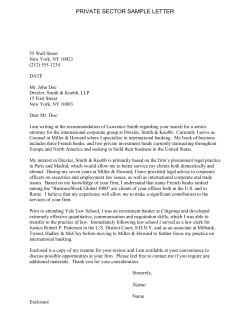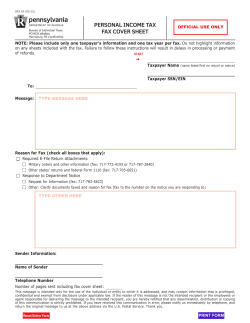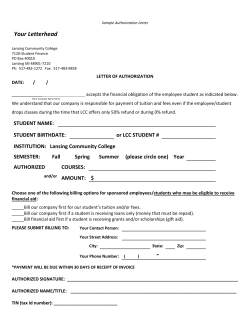
Power of Attorney Authorization to Disclose Tax Information CLEAR FORM
CLEAR FORM Power of Attorney Authorization to Disclose Tax Information PART I MONTANA POA Rev 01 13 Please type or print. See the separate instructions. Caution! Each taxpayer must complete a separate power of attorney form. This form will not be honored for any purpose other than representation before the Department of Revenue. Notice: The department will accept Federal Form 2848 as creating a power of attorney for representation before the Department of Revenue if the form is completed and in Part I, Section 3, Matters, the taxpayer identifies “Montana” and the type of tax, tax form number, and year(s) or period(s) that the representative is authorized to discuss with the Department of Revenue. If completing the federal form, a copy must be provided to the Department of Revenue. 1. Taxpayer Information. Taxpayer must sign and date this power of attorney on page 2, section 6. Taxpayer Name and Address Taxpayer Identification Number(s) Telephone Number hereby appoints the following representative(s) as attorney(s)-in-fact: 2.Representative(s) must sign and date this form on page 2, Part II. If you are a representative and want to withdraw from an existing power of attorney form previously filed with the Department of Revenue, simply write WITHDRAW across the top of the form, sign the form in Part II, and file the form as indicated on the bottom of page 2. Name and Address PTIN Telephone Number FAX Number Email Address Name and Address PTIN Telephone Number FAX Number Email Address to represent the taxpayer before the Montana Department of Revenue for the following matters: 3. Tax Matters and Tax Years Covered by this Form Your representative is authorized to inspect, receive and discuss confidential information for the tax types and tax years you authorize by checking the appropriate boxes below and inserting the exact tax years. You may include only future tax periods that end no later than three years after the date the form was received by Department of Revenue. If tax matters and tax periods are not specified, this written authorization will not be in effect. Insert exact tax years Insert exact tax years q Individual Income Tax __________________ q Rental Vehicle Tax ____________________ q Corporation License Tax __________________ q Withholding Tax ____________________ q S Corporation __________________ q Lodging Facilities Tax ____________________ qPartnership __________________ q Combined Oil and Gas Tax ____________________ q Other, please specify ____________________ 4. Acts Authorized by This Form Check the box that best describes what authorization you are delegating to your representative. q Representation. Department employees can provide confidential tax information to the representative and discuss the information. (This is the most frequent response.) q Information sharing. Department employees can provide confidential tax information to the representative, but cannot discuss the information. q Decision making authority. Department employees can provide confidential information to a representative, can discuss the information and the representative can act on the taxpayer’s behalf for all purposes, including settlement and waiver of appeal rights. 5. Retention/Withdrawal of Prior Power(s) of Attorney. The filing of this power of attorney automatically withdraws all earlier power(s) of attorney on file with the Montana Department of Revenue for the same matters and years or periods covered by this document. If you DO NOT want to withdraw a prior power of attorney, check here. q You must attach a copy of any power of attorney you want to remain in effect. This authorization to disclose taxpayer information does not affect the routine mailing of tax forms, refund checks, original notices or other original communications, which will continue to be sent only to the taxpayer. 6. Signature of taxpayer. If a tax matter concerns a year in which a joint return was filed, the husband and wife each file a separate power of attorney even if the same representative(s) is(are) appointed. If signed by a corporate officer, partner, guardian, tax matters partner, executor, receiver, administrator, fiduciary, or trustee on behalf of the taxpayer, I certify that I have the authority to execute this form on behalf of the taxpayer. If not signed and dated, this power of attorney will be returned to the taxpayer. _______________________________________ Signature _____________________ Date _______________________________________ Print Name ___________________________________ Title (if applicable) ___________________________________ Print name of Taxpayer from Line 1 (if other than individual) PART II. Declaration of Representative I declare that: I am authorized to represent the taxpayer identified in Part I for the matter(s) specified there; and I am one of the following: a. Attorney - licensed to practice law in the jurisdiction shown below. b. Certified Public Accountant - duly qualified to practice as a certified public accountant in the jurisdiction shown below. c. Officer - a bona fide officer of the taxpayer’s organization. d. Full time employee - a full time employee of the taxpayer. e. Family member - a member of the taxpayer’s immediate family (for example, spouse, parent, child, grandparent, step-parent, step-child, brother, or sister). f.Other If this declaration of representative is not signed and dated, the power of attorney will be returned to the taxpayer. Representatives must sign in the same order listed in section 2 of part i above. See instructions for Part II. Designation Insert Letter from Above (a-f) Relationship to Taxpayer (see instructions for Part II) Signature Date Filing this Form Mail or fax the completed form directly to the Montana Department of Revenue: Montana Department of Revenue Legal Services, Disclosure Office 125 N. Roberts PO Box 7701 Helena, MT 59604-7701 Fax: (406) 444-4375 If you are already working with a department employee, please feel free to fax your completed form directly to that person. Instructions for Power of Attorney Authorization to Disclose Tax Information What’s New Joint returns. Joint filers must now complete and submit a separate power of attorney for each taxpayer. Retention/ Withdrawals. The filing of this power of attorney will withdraw all earlier powers of attorney relating to the same tax matter, years, or periods unless you check the box in Section 5. Declaration of Representation. The representative must sign the power of attorney. Part I Section 1. Taxpayer Information. Individual. Enter your name, personal address, social security number (SSN), individual taxpayer identification number (ITIN), and/or employee identification number (if applicable), and telephone number. Do not use your representative’s address or post office box for your own. If you file a tax return that includes a sole proprietorship business (federal Schedule C) and the matters that you are authorizing the listed representative(s) to represent you include your individual and business tax matters, including employment tax liabilities, enter both your SSN (or ITIN) and your business EIN as your taxpayer identification numbers. If the tax matter concerns a joint return, a separate power of attorney is required for each spouse. C Corporation, S corporations, partnership, limited liability company or association. Enter the name, business address, (federal employer identification number) FEIN, and telephone number. If this form is being prepared for C corporations filing a combined tax return, a list of subsidiaries is not required. This power of attorney applies to all members of the combined tax return. Trust. Enter the name, title, address of the trustee, and the name and FEIN of the trust, and telephone number. Estate. Enter the name of the decedent as well as the name, title, and address of the decedent’s personal representative. Enter the estate’s EIN for the taxpayer identification number, or, if the estate does not have an EIN, enter the decedent’s SSN (or ITIN). Section 2. Authorization of Representative. Enter your representative’s full name. Only individuals may represent you before the Department of Revenue. Use the identical full name on all submissions and correspondence. Enter the representative’s telephone number, address or post office box, and e-mail address, if applicable. If a trust, estate, guardianship, or conservatorship wants an individual other than the personal representative, trustee, or other fiduciary to handle tax matters before the Department of Revenue, the personal representative, trustee, or other fiduciary must complete this form and designate the other individual with the power of attorney. Otherwise, the personal representative, trustee, or other fiduciary has the requisite authority to handle tax matters before the Department of Revenue and need not complete this form. A representative that wants to withdraw from an existing power of attorney, should write WITHDRAW across the top of the form, sign the form in Part II and file the form as indicated at the bottom of the form. Section 3. Tax Matters and Tax Years Covered by the Form. Indicate, by checking the appropriate boxes, what tax types you are authorizing your representative to inspect, receive and discuss with the Department of Revenue You may list any tax years or periods that have already ended as of the date you sign the form (specific years must be entered, a reference such as “all” will not be accepted). You may only include up to three future tax periods that end after the current tax year. If the matter relates to estate tax, enter the date of the decedent’s death instead of a tax year. If tax matter and tax periods aren’t specified, the form will be returned to the taxpayer. Section 4. Acts Authorized by this Form. If you are providing authorization to another individual, check one of the three boxes, depending on what authorization you are providing to your representative. A disclosure authorized by this form may take place by telephone, letter, facsimile, e-mail or a personal visit. Note: Checking the “yes” box on the individual tax return answering the question “Do you want to allow another person (third party designee) to discuss this return with us?” authorizes the Department of Revenue employees to discuss the tax return itself with the third party designee. Any other issues, such as outstanding tax liabilities, cannot be discussed without a completed power of attorney form. Section 5. Retention/Withdrawal of Prior Power(s) of Attorney This section is used by taxpayer to change a power of attorney status. The filing of a new power of attorney automatically withdraws all earlier power(s) of attorney on file with the Montana Department of Revenue for the same matters and years or periods covered by this document. If you do not want to withdraw a prior power of attorney, check the box in this section. Section 6. Signature Individual. You must sign and date the form. If a joint return has been filed, your spouse must execute his or her own Montana power of attorney to designate a representative. Corporation or association. An officer having authority to bind the corporation must sign. Partnership. All partners must sign unless one partner is authorized to act in the name of the partnership. A partner is authorized to act in the name of the partnership if, under Montana law, the partner has authority to bind the partnership. If there is any doubt whether a partner has the authority to bind the partnership, it is best that all partners sign the form. Limited Liability Company (LLC). If the LLC is member managed, all members must sign, unless one member is authorized to act in the name of the LLC. If the LLC is manager managed, the manager must sign. Estate, trust or other fiduciary. As discussed in Section 2, if a trust, estate, guardianship, or conservatorship wants an individual other than the personal representative, trustee, or other fiduciary to handle tax matters before the Department of Revenue, the personal representative, trustee, or other fiduciary must complete this form and designate the other individual with the power of attorney. Thus, the personal representative of an estate must sign. The trustee of a trust must sign. If a guardian or conservator has been appointed for a taxpayer, the guardian or conservator must sign. In all cases, the fiduciary must include the representative capacity in which the fiduciary is signing, such as “John Doe, guardian of Jane Roe.” Part II. Declaration of Representative The representative(s) you name must sign and date the Declaration of Representative. If there is more than one representative, each must sign and date in the same order listed in Section 2 of Part I. The representative(s) must enter the applicable designation (items a-f) under which the representative is authorized to handle matters before the Department of Revenue. In addition, the representative(s) must provide a brief description of the representative’s relationship to the taxpayer: a. Attorney – Enter the two-letter abbreviation for the state in which the attorney is admitted to practice. b. Certified Public Accountant – Enter the two-letter abbreviation for the state in which the CPA is licensed to practice. c. Officer – Enter the title of the officer (for example, President, Vice President, Secretary, etc.). d. Full-Time Employee – Enter title or position (for example, Comptroller, Accountant, etc.). e. Family Member – Enter the relationship to the taxpayer (for example, spouse, parent, child, brother, sister, etc.). f. Other – Identify the type of representative and enter a brief description of the representative’s relationship to the taxpayer. Filing this Form Mail or fax the completed form directly to the Montana Department of Revenue: Montana Department of Revenue Legal Services, Disclosure Office 125 North Roberts PO Box 7701 Helena, MT 59604-7701 Fax: (406) 444-4375 If you are already working with a department employee, please feel free to fax your completed form directly to that person.
© Copyright 2025





















